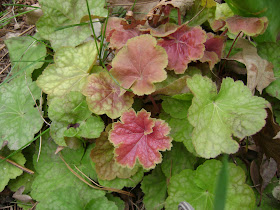Unfortunately, my garden is not home to many spring wildflowers. Judging by all the seedlings of native Rudbeckias, Obedient Plant, Monarda, and other unidentified plants popping up all over my butterfly garden this spring, I will have a bounty of wildflowers/natives to share on upcoming WW's. But for now, the only true wildflowers I have are pretty common ones--and not necessarily plants you are excited to see blooming in your garden.
Viola papilionacea, the common violet, is sprouting up everywhere. My granddaughter loves these and calls the little flowers "bluebirds." It's hard not to like these delicate bluish purple blooms and the heart-shaped leaves, but I do wish they were better behaved! I have chosen to pull them up out of the flowerbeds and among the rocks bordering the house's foundation rather than take more drastic measures. You would think they would show their appreciation for my kinder approach and move to areas where they are welcome--like under the big spruce tree.
Editor's Note: I forgot to add while writing this post, that the common violet also happens to be the state flower of Illinois; thanks, Barbara, for reminding me of this!
Another plant threatening to take over several of the less-cultivated areas of the garden is Glechoma hederacea, also known by several names including ground ivy or "Creeping Charlie." This is a plant I have zero tolerance for, but it seems to laugh at my efforts to eradicate it. It is a member of the mint family, which explains its aggressive tendencies, and forms rootlets wherever the foliage touches the ground. While I find it hard to call this a wild "flower," it is listed in Illinois Wildflowers, albeit as a "weedy wildflower." It does have one redeeming feature according to this website: it is an important source of nectar in the spring for the bees.
Last fall I had so many crocus bulbs that I was searching for a place to plant them and had the bright idea to plant them randomly near the pine trees across the lane, envisioning a field of crocuses come spring. That vision turned into a pretty wimpy "field," but this past week I have had a much more impressive field of yellow visible to all passersby. Unfortunately, the field of yellow was mown down by my husband before I thought to take a photo, so this less impressive view of the front lawn will have to do.
Yes, the bright color in the lawn is provided by Taraxacum officinale, the common dandelion. We do not spray our lawn with any kind of chemicals, so the dandelions have free rein here. I really don't mind them that much--after all, the grandkids need to be able to make "daisy chains" and little bouquets for their mothers.
But I'm not so appreciative of their moving into other spaces. I guess this dandelion was trying to camoufluage itself as a tulip:)
Speaking of tulips . . . while I don't have many spring wildflowers, this past week has been the height of the season for all other spring bloomers.
Late daffodils are still blooming, but it's the tulips taking center stage. I have so many different kinds, some from previous years as well as new ones, that I can't remember the names of many of them. This is a new variety planted this year; I thought it was 'Pink Impression,' but older 'Pink Impressions' were a solid pink, not this two-toned variety. I really need to dig through all my records some time.
A few yellow-striped cream tulips are scattered here and there, possibly 'Vanilla Cream,' but possibly not. Notice the raindrops on the petals--we have had rain for days on end, it seems. Planting is at a standstill while I wait for the garden to dry out, but the tulips are loving this cooler and wetter spring and are lasting much longer than last year's unusually warm spring.
How is this for an eye-catcher? This is a new addition to the lily bed this year, so I do remember its name--'Professor Rontgen.' It certainly is more flamboyant than any professors I had in college.
The last tulips to open are always the 'Angeliques,' my favorite of all. I'm not sure if I consciously planned this little vignette with the pale pink 'Angeliques' and the sweet little muscari, but I'll take credit for it if anyone asks me.
Tulips aren't the only blooms commanding attention right now. The redbuds have filled out nicely in the last two weeks, adding that bright lavender to home landscapes and roadsides.
Like the spring ephemerals, their time is short--already a few leaves are beginning to develop, signaling the end of blooming time.
Even more fleeting are the crabapple blooms. They were just beautiful on Easter Sunday, but after some strong winds today, I noticed the lane is covered with pale pink petals. The darker crabapples seem to hold their flowers longer. I am just happy to see them bloom at all this year after last year's disappointing and brief showing.
The white crabapple never fails to disappoint, though. It is usually later than the pink or reds and hangs on to its blossoms longer.
These are busy days here at the Prairie, with not enough time for blogging it seems. Before the spring show is over, I do want to write a post on just the tulips, which have been spectacular--maybe early next week. There is no need to be sad, though, about their departing blooms--there is always something waiting in the wings to take their place. Very, very soon it will be the lilacs!
Be sure to check out other Wildflower Wednesday posts, where I'm sure you'll see some real wildflowers.






















































